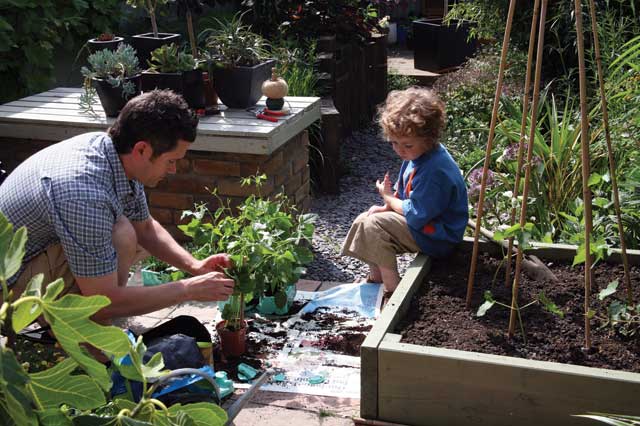'I'm the urban space man': How Martyn Cox became the king of the small city plot

Martyn Cox didn't exactly mean to become a gardener. "I thought I'd be an artist or a musician," he laughs, remembering the six months he spent at home, sitting on the sofa after leaving school. "I was mainly watching Going for Gold. In the end my dad said, 'Come on, you've got to do something.'"
The "something" ended up being a City & Guilds course in horticulture at his local Nottinghamshire college, and Cox found himself hooked. Though four-and-a-half years working as a propagator put him firmly off nurseries ("Unloading lorries that had just arrived from Holland at 10pm in the middle of winter – brrr"), he finally found his métier while making floral displays for the local authority. "I loved it: fill up the van with plants, drive somewhere, decorate. Police HQ, County Hall, fashion shows at the local poly..."
Cox's training in floral decoration still shows in his own minute Walthamstow garden (which he opens once a year for the National Gardens Scheme, this year on 27 June). Thirty by 15 – and that's feet – the plot packs an amazing punch for its size. Last summer, it accommodated several different ripening varieties of tomatoes, cucumbers, tomatillos, a monster grapevine and 20 other kinds of fruit, as well as Cox's wonderful collection of aeoniums, the big succulents, a greenhouse, a seating area, a wildlife pond with actual creatures living in it, and several trees.
It's his instinct to squash more in, to cover up the ugly bits of a neighbour's fence or his own dustbins, to distract the eye, and to plant upwards, which give his garden the real oomph factor. And it's hard not to assume that several years in municipal set-dressing didn't teach him some of this. He learnt a life-long passion for spider plants, certainly. "Well, I'm a child of the 1970s. Spider plants and Doctor Who! But they're great," he says, becoming more serious. "They can grow in a tiny pot, but have lots of top growth, which disguises the container completely. They need hardly any fuss, and you can tip them up, grow them on their sides; they're a brilliant plant for the most minute of spaces."
You can find all Cox's enthusiasm, knowledge and 1970s references in his new book, Big Gardens in Small Spaces (Timber, £18.99). It's rare to find an informative gardening text that's also a flowing read, but Cox has unstoppable energy and is always looking for something new – two qualities that make him an engaging writer. The subtitle – "out-of-the-box advice for boxed-in gardeners" – is beautifully accurate. It's hard not to end up pretty grateful his dad gave him a bit of a nag.
Cox's tiny-garden tips
Lose the compost bin
Cox recycles all his garden waste and has a wormery (above) for all his kitchen waste Can-O-Worms, £89, wigglywigglers.co.uk
Restrict the palette
"Going bonkers for every colour under the sun is not pleasing on the eye," says Cox. "In a tiny garden, a basic backdrop of cool green with spots of colour creates unity"
Slim down your grow-bags
Long, deep and narrow, canoe-shaped grow-bags are just right for tiny urban gardens. See vitalearth.tv for stockists
Small but still fun
"The kids have a pond for dipping, forests for toy soldiers, slate paths for trucks, and can play where no adults can see them"
Subscribe to Independent Premium to bookmark this article
Want to bookmark your favourite articles and stories to read or reference later? Start your Independent Premium subscription today.

Join our commenting forum
Join thought-provoking conversations, follow other Independent readers and see their replies